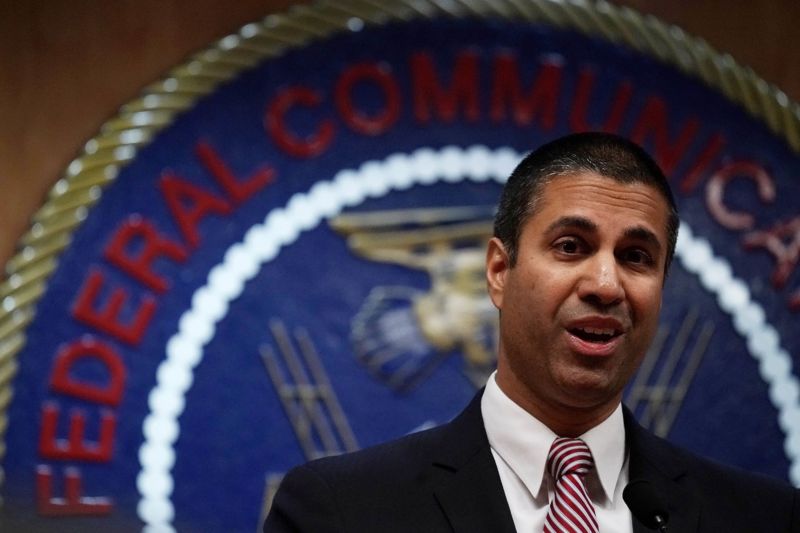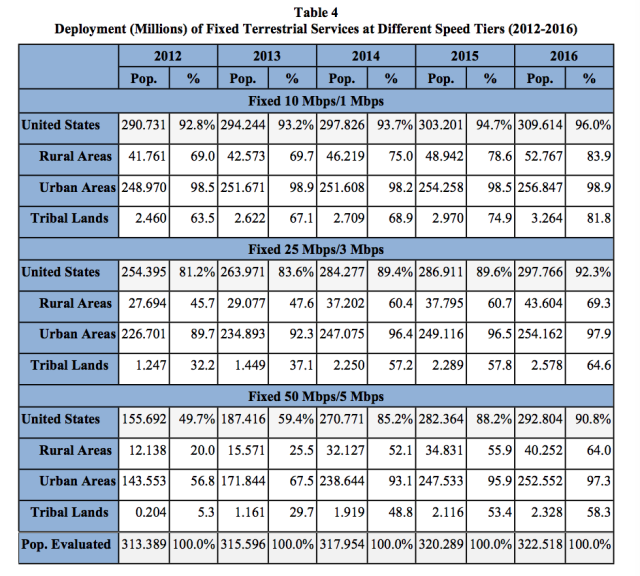[ad_1]

Ajit Pai had a dilemma when overseeing the creation of the Federal Communications Commission’s new Broadband Deployment Report.
Anyone who is familiar with the FCC chairman’s rhetoric over the past few years could make two safe predictions about this report. The report would conclude that broadband deployment in the US is going just fine and that the repeal of net neutrality rules is largely responsible for any new broadband deployment.
But the FCC’s actual data—based on the extensive Form 477 data submissions Internet service providers must make on a regular basis—only covers broadband deployments through December 2016. Pai wasn’t elevated from commissioner to chairman until January 2017, and he didn’t lead the vote to repeal the net neutrality rules until December 2017. And, technically, those rules are still on the books because the repeal won’t take effect for at least another two months.
The timing means that it would be impossible for Pai to present evidence today that broadband deployment is increasing as a result of the net neutrality repeal. But the report claims that’s exactly what happened anyway and says that future data will bear that out. To support its argument, the report claims that broadband deployment projects that were started during the Obama administration were somehow caused by Pai’s deregulatory policies.
Two weeks ago, we noted that a fact sheet issued by Pai offered no data to back up his deployment claims. The full report was released Friday, so now we can take a deeper look at its conclusions and reasoning.
Why the broadband report matters
In Section 706 of the Telecommunications Act of 1996, Congress required the FCC to encourage broadband deployment to all Americans and to make a regular determination of “whether advanced telecommunications capability is being deployed to all Americans in a reasonable and timely fashion.” If the FCC finds that broadband isn’t being deployed quickly enough, it has to “take immediate action to accelerate deployment of such capability by removing barriers to infrastructure investment and by promoting competition in the telecommunications market.”
During the Obama presidency, the FCC regularly found that broadband deployment wasn’t happening quickly enough. But in the first deployment report since Pai became chairman, the FCC “conclude[s] that advanced telecommunications capability is being deployed to all Americans in a reasonable and timely fashion.”
“[T]his finding does not mean that all Americans now have broadband access. Rather, it means that we are back on the right track when it comes to deployment,” the report continues.
Data “does not yet reflect” benefits of net neutrality repeal
The lack of data since the FCC got “back on the right track” doesn’t change the finding. Instead, the report says that the December 2016 data simply “does not yet reflect the beneficial effects of the Commission’s actions in 2017,” such as “ending the adverse impact on investment caused by the [2015 net neutrality] Order.”
The net neutrality repeal will allow ISPs to block and throttle Internet traffic or prioritize traffic in exchange for payment. The repeal also eliminates several other consumer protections, such as a requirement that ISPs be more transparent with customers about hidden fees and the consequences of exceeding data caps.
The repeal is on a list of “commission efforts to close the digital divide,” along with other deregulatory actions taken by Pai and even some broadband deployment actions taken during the Obama administration.
For example, the report favorably cites an expansion of the Lifeline program for low-income Americans that happened in March 2016, even though Pai’s FCC has since taken steps that make it harder for ISPs to sell Lifeline-subsidized broadband plans.
Pai’s move to eliminate price caps imposed on some business broadband providers also made the list. That decision relied upon an FCC analysis that claimed a local market can be deemed “competitive” even if most customers have only broadband choice.
“New” AT&T and Verizon deployments
As evidence of the beneficial effects of Pai’s policies, the FCC says that “the marketplace is already responding to the more deployment-friendly regulatory environment now in place.”
The FCC then provides two sentences’ worth of evidence for this claim.
“For instance, several companies, including AT&T, Verizon, Frontier, and Alaska Communications either commenced or announced new deployments in 2017,” the report concludes. “These new deployments are initial indicators that deployment is likely to accelerate again in part due to our recent efforts.”
Why are those companies increasing broadband deployments? According to the FCC, one of the main reasons was the commission’s decision to repeal net neutrality rules and eliminate the classification of ISPs as common carriers. For evidence that this is what caused broadband progress to improve, the FCC simply cites its own repeal order from December 2017, which said that deregulating Internet service would “encourage broadband investment and innovation, furthering our goal of making broadband available to all Americans.”
But as we’ll see in the next section, three of these four deployments were planned during the Obama administration, and two were funded directly by the FCC before Pai was the chair. All four came from ISPs that had announced broadband expansions before Pai took over, with the net neutrality rules in place.
Those ISPs were already expanding broadband

Since the FCC’s evidence that the net neutrality repeal created broadband deployment is limited to announcements from four companies, one might expect that those companies weren’t expanding broadband while net neutrality rules were in place.
But they were expanding broadband with net neutrality rules in place, including specific projects that Pai took credit for even though they started before he was chair.
The FCC’s evidence that AT&T is boosting broadband because of the net neutrality repeal comes from a January 2018 announcement. AT&T announced at the time that it had “fulfilled its promise to make high-speed Internet available to over 440,000 homes and small businesses in hard-to-reach locations across 18 states by the end of 2017.”
Notice that these deployments occurred entirely in 2017, when net neutrality rules were in place. Moreover, these deployments were planned during the Obama administration and can be directly attributed to FCC policies under Obama and then-FCC Chairman Tom Wheeler.
In August 2015, the Wheeler-led FCC awarded AT&T with $428 million in annual funding to bring 10Mbps Internet service to parts of rural America. AT&T was required to deploy broadband to 1.1 million rural homes and businesses over six years to meet its Connect America Fund commitment, and it had to complete the first 40 percent of those deployments by the end of 2017.
Thus, the AT&T announcement in January 2018 was simply the fulfillment of a broadband deployment program set in course by the Wheeler FCC.
In addition to that, AT&T agreed to deploy fiber-to-the-premises to 12.5 million customers in July 2015 when it purchased DirecTV. This deployment was required by the Wheeler-led FCC as part of the merger approval.
[ad_2]
Source link













